
Treatment of Anterior Tooth Trauma with the Hybrid Ceramic VITA ENAMIC
Children's anterior teeth are often affected by fractures. Particularly with regard to mixed dentitions, the question arises as to the ideal treatment of these traumatic defects. The roots have not yet completely formed and the juvenile pulp chamber is highly pronounced, which is why a full crown preparation is contraindicated. If the fragment cannot be repositioned adhesively, a direct composite structure is usually fabricated, which often has to be renewed before the final restoration. In the following segment, dentists Dr. Angela Stanislavovna Brago and Yulianna Ivanovna Enina demonstrate how these types of traumas are defect-oriented and can definitively be treated with VITA ENAMIC (VITA Zahnfabrik, Bad Säckingen, Germany), due to the dentine-like elasticity of the hybrid ceramic and its ability to be processed to high edge stability.
Trauma incurred while skateboarding
A nine-year-old patient arrived after falling from a skateboard. The child had a longitudinal fracture in the crown that extended palatally to the subgingival area. Radiological and clinical examinations showed no opening of the pulp, and a physiological movement of the tooth. Vitality was positive and percussion was negative. After applying local anesthesia, the palatal fracture area was exposed by gingivectomy, the fracture was sealed with an adhesive wound dressing and given a provisional treatment. After a healing period of one week, the provisional filling was removed, the fracture lines were finished and the sharp edges were rounded off. This was followed by analogue molding, model creation and laboratory scanning.
Defect-oriented, biomimetic reconstruction
As hybrid ceramic allows for delicate reconstructions with wall thicknesses of 0.2 mm and can be reliably fixed to a proven, all-ceramic protocol, an absolutely defect-oriented restoration could be constructed using CAD software. Afterwards, the reconstruction was fabricated using CAM technology, prepared and inserted intraorally. After a minimal modification, the fluorosis of the natural tooth structure was reproduced vestibularly. The surface was preconditioned and characterized with light-curing VITA ENAMIC STAINS and glazed. Thanks to dentine-like elasticity and enamel-like abrasion behavior, the fracture was treated with a functional and long-lasting hybrid ceramic solution.
Trauma incurred playing soccer
A 15-year-old patient had suffered a crown fracture at tooth 22 during the previous week when playing football and complained of discomfort. The examination diagnosed a deep longitudinal crown fracture without an opening of the pulp. Percussion was negative, tooth movement was physiological. The vitality test showed a clear overreaction of the pulp, and for that reason, irreversible pulpitis was assumed. Since a radiological examination demonstrated completed root development, the decision was made to perform a root canal treatment before the definitive reconstruction. After successful therapy and no complaints of pain, a minimal marginal preparation was made for a definitive veneer restoration.
Minimally-invasive restoration with chameleon effect
Tooth 22 had been severely weakened as a result of trauma and trepanation. For that reason, it became all the more important to take a minimally invasive approach in carrying out the restoration and to use full adhesive to fix the tooth for stabilization. After analog impression, model fabrication and laboratory scanning, a wafer-thin marginal restoration (0.2 mm wall thickness) was designed and manufactured using CAD/CAM technology. Thanks to the high edge stability of the hybrid ceramic, the greatest possible ferrule effect was achieved, while also preserving the remaining tooth structure. The fully adhesive incorporation was carried out according to the tried and tested all-ceramic protocol. The biomimetic properties of VITA ENAMIC, excellent CAM processing capabilities and reliable material conditioning led to the great long-term clinical success for this hybrid ceramic reconstruction. Thanks to the good photo-optical properties of the material, the treatment was integrated harmoniously into the natural dentition.
Report 11/18
Dr. Angela Stanislavovna Brago and Dr. Yulianna Ivanovna Enina
Sechenov University, Moscow, Russia
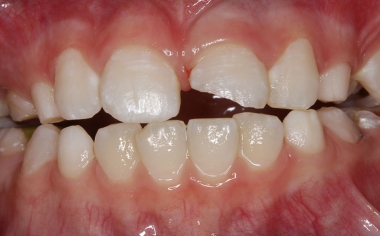
Case study 1
Fig. 1: Initial situation: Condition after vestibular trauma following a skateboard accident.
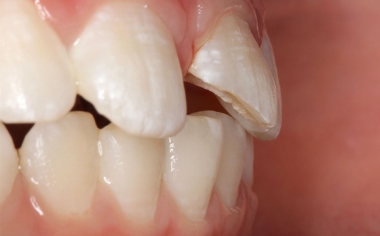
Case study 1
Fig. 2: The pulp was not opened and could be protected using adhesive wound dressing.
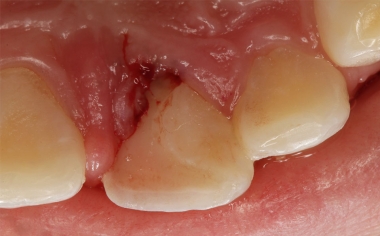
Case study 1
Fig. 3: The palatal fracture line extended deep into the subgingival area.
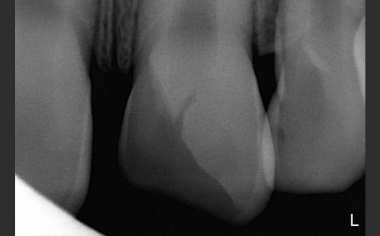
Case study 1
Fig. 4: A radiological examination showed no opening of the pulp.
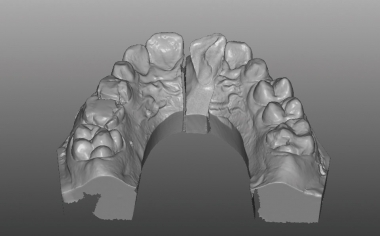
Case study 1
Fig. 5: The exposed palatal fracture line after gingivectomy in the virtual model.
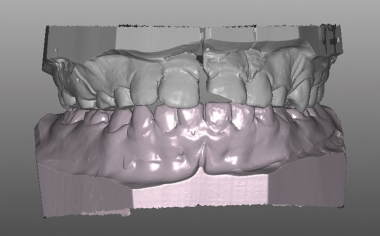
Case study 1
Fig. 6: The longitudinal crown fracture of the vestibular in the digitized master model.
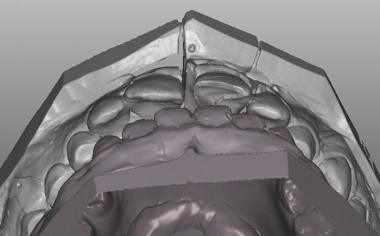
Case study 1
Fig. 7: The enamel-like abrasion made long-lasting and functional anterior guidance via tooth 21 possible.
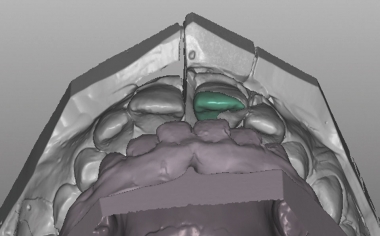
Case study 1
Fig. 8: Thanks to the low minimum layer thickness, it was possible to construct a defect-oriented contact area.
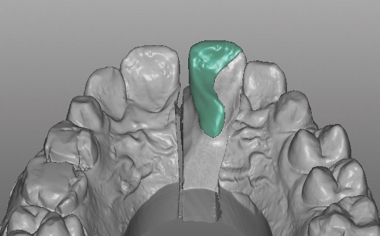
Case study 1
Fig. 9: The defect-oriented construction of the palatal hybrid-ceramic restoration.
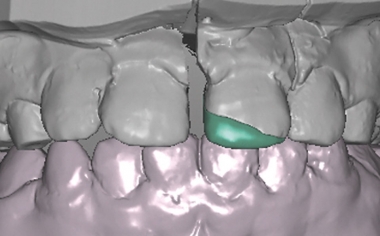
Case study 1
Fig. 10: The restoration also followed the fracture course from vestibular.
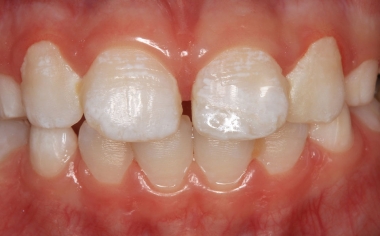
Case study 1
Fig. 11: Thanks to the precise grinding results, the restoration was perfectly aligned with the defect.
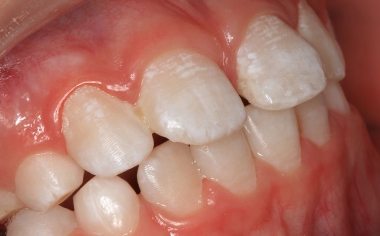
Case study 1
Fig. 12: Result: After characterization with VITA ENAMIC STAINS, the restoration was integrated harmoniously.
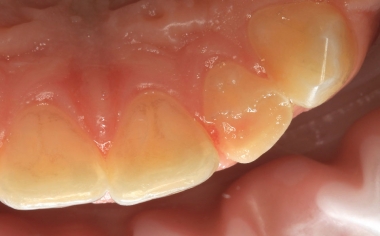
Case study 2
Fig. 1: Initial situation: The palatal fracture line of tooth 22 served as a defect-oriented preparation margin.
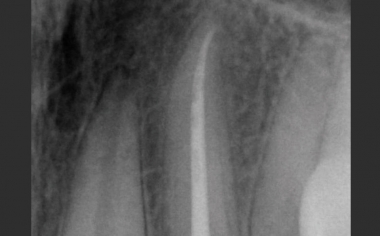
Case study 2
Fig. 2 Tooth 22 after root canal treatment.
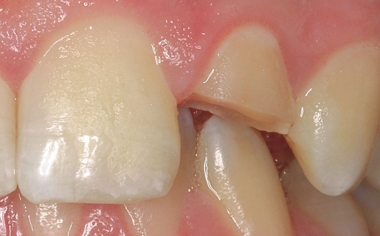
Case study 2
Fig. 3: The minimally invasive marginal preparation enabled long-lasting anchoring of the restoration.
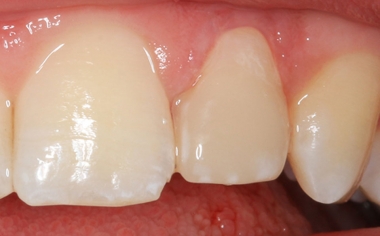
Case study 2
Fig. 4: Result: The hybrid ceramic restoration integrated perfectly into the natural dentition.